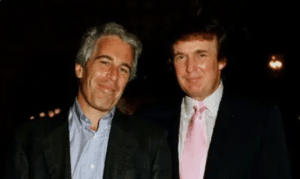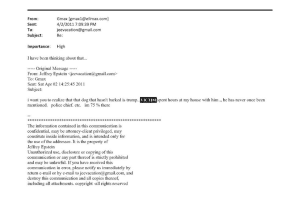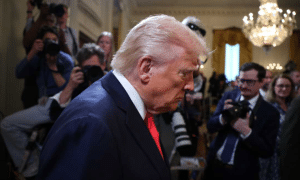PNN – The release of new emails from Jeffrey Epstein has once again brought Trump’s name into the spotlight of this controversial case; documents that have raised new questions and, this time, revealed some truths.
On Wednesday, November 12, Democrats on the U.S. House Oversight Committee detonated a political bombshell that is still shaking the White House. The release of three emails from the private correspondence of convicted sex trafficker Jeffrey Epstein has once again placed Donald Trump at the center of one of the darkest sexual-misconduct scandals in modern American history. These emails, part of the 23,000 documents subpoenaed from Epstein’s properties, contain claims that sharply contradict Trump’s official account of his relationship with Epstein.
But this is only the beginning. The Epstein case, buried in silence for years, has now become one of the most dangerous political challenges facing Trump—a challenge that has even angered some of his “America First” (MAGA) supporters and could cast a long shadow over the 2028 presidential election.
The Epstein–Trump File: From a Sex-Trafficking Network to a Controversial Relationship
Jeffrey Epstein, an American billionaire and hedge-fund manager, moved among the political, economic, and entertainment elite throughout the 1990s and 2000s. He socialized with figures such as Bill Clinton, Prince Andrew, Bill Gates, and of course Donald Trump. Yet behind this polished façade was a horrifying network of sexual exploitation involving underage girls.

Investigations show that Epstein sexually abused and trafficked dozens of teenage girls in his mansions in New York and Palm Beach, Florida, between 2002 and 2005 in an organized network. With the help of his right-hand man, Ghislaine Maxwell, he lured girls with promises of money and jobs, then forced them to perform sexual acts and even encouraged them to recruit other girls, a structure that prosecutors called a “sex trafficking pyramid.”
The year 2005 was a turning point in the case. The family of a 14-year-old girl reported to Palm Beach police that Epstein had raped her. A massive investigation began and the FBI opened a case called “Operation Leap Year,” but what happened in 2008 was one of the most controversial plea deals in American history.
Florida federal prosecutor Alexander Acosta (later appointed by Trump as labor secretary) signed a confidential agreement with Epstein’s lawyers. Under the deal, Epstein pleaded guilty to just two minor charges of “soliciting sexual favors from a minor” and was sentenced to 18 months in prison, while he was required to answer 60 federal charges. He was even allowed to spend six days a week in his office, returning to his cell only at night. After 13 months, Epstein was released.
It was during this time that Trump and Epstein’s relationship took shape. A video from 1992 shows the two dancing together at a party at Mar-a-Lago, Trump’s private club. Epstein attended Trump’s wedding to American actress and television host Marla Maples in 1993, and flight records show that Trump traveled on Epstein’s private jet at least seven times.
In 2002, Trump told New York magazine about Epstein: He’s a wonderful person. He’s a pleasure to be around. They even say he likes beautiful women as much as I do, and many of them are younger. That statement now takes on a new meaning in light of the new emails.
Trump has always claimed that he broke off relations with Epstein in the mid-2000s and fired him from the Mar-a-Lago club for inappropriate behavior with young female employees, but new emails cast doubt on that narrative.
Epstein’s right-hand woman, Ghislaine Maxwell, was tried and sentenced to 20 years in prison in 2021. She was accused of helping Epstein recruit and abuse underage girls. Maxwell is the person Epstein talks to about Trump in the new emails.
Newly released emails; what new secrets were revealed?
Three key emails released by Democrats paint a different picture of the Trump-Epstein relationship;
Email 1 – April 2, 2011: In this email, Epstein writes to Ghislaine Maxwell: I want you to understand that the dog that didn’t bark is Trump… [name of victim redacted] has been at my house with him for hours and he is never mentioned. The police chief and everyone else… I’m there 75 percent of the time. The email shows that Epstein believed Trump had a lot of information about him but remained silent. Virginia Gioffrey, one of Epstein’s known victims who committed suicide in April 2025, is the same person Republicans have identified as the person mentioned in the email.

Second email – December 16, 2015: Wolf writes to Epstein: I hear CNN is going to ask Trump tonight about his relationship with you. Epstein asks what he should say. Wolf advises: I think you should let him get himself caught. If he says he wasn’t on the plane or in your house that gives you a valuable public relations and political tool. You can hang him in a way that creates a positive benefit for you, or if it really looks like he could win, you can bail him out…

Email 3 – January 2019: In this message to author Michael Wolff, Epstein writes: Trump said he asked me to resign, even though I was never a member. Of course, he knew about the girls, because he asked Ghislaine to stop. The email directly questions Trump’s claim that he was unaware of Epstein’s crimes.

These emails show that Epstein and Wolff were strategizing against Trump, and that Epstein believed he had damaging information about Trump that he could use.
Political reflection and the future of the case; Democrats’ trump card or a storm in a teacup?
The Epstein case has become one of the few issues in 2025 that could drive a wedge between Trump and parts of his loyal base. Polls show that while a majority of Republicans still support Trump overall (87 percent), approval of his handling of the Epstein case is noticeably lower (45 percent), a trend that analysts see as a sign of conservative public sensitivity to the issue of sexual abuse and the need for transparency. This same gap could affect the 2026 electoral atmosphere and even the 2028 presidential race.

The White House and Trump’s own behavior in dealing with the case has also raised serious questions. Private meetings in the Situation Room to dissuade lawmakers, strong opposition to the vote, and the president’s prolonged silence have led some analysts to believe that the administration is concerned about the potential consequences of releasing the documents. Although none of the emails provide definitive evidence of Trump’s involvement, the contradiction between their content and Trump’s official narrative has left room for political and media speculation.
At the same time, the fact that the names of other prominent figures, from Bill Clinton to Bill Gates and Prince Andrew, have also been mentioned in various documents has allowed Trump to describe the issue as a “bipartisan political game.” The key point, however, is that American public opinion is highly sensitive to the Epstein issue. Many voters believe the case is a symbol of structural corruption, elite immunity, and the inefficiency of the justice system—a concept that affects people beyond party affiliation.

